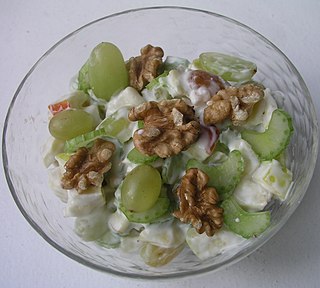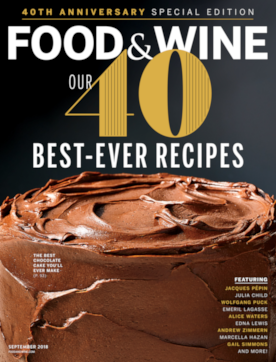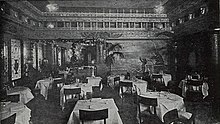
Koreatown, or K-Town, is an ethnic Korean enclave in Midtown Manhattan, New York City, centered on 32nd Street between Madison Avenue and the intersection with Sixth Avenue and Broadway, which is known as Greeley Square. The neighborhood in Midtown South features over 150 businesses of various types and sizes, ranging from small restaurants and beauty salons to large branches of Korean banking conglomerates. Koreatown, Manhattan, has become described as the "Korean Times Square" and has emerged as the international economic outpost for the Korean chaebol.

A Waldorf salad is a fruit and nut salad generally made of celery, fresh apples, walnuts, and grapes, dressed in mayonnaise, and traditionally served on a bed of lettuce as an appetizer or a light meal. The apples, celery, and grapes can all be green, which harmonizes the color palette of the dish.

An automat is a fast food restaurant where simple foods and drinks are served by vending machines and there is typically no waitstaff. The world's first automat, Quisisana, opened in Berlin, Germany in 1895.

The cuisine of New York City comprises many cuisines belonging to various ethnic groups that have entered the United States through the city. Almost all ethnic cuisines are well represented in New York, both within and outside the various ethnic neighborhoods.
Ladies who lunch is a phrase often used to describe well-off, well-dressed women who meet for social luncheons, usually during the working week. Typically, the women involved are married and non-working. Normally the lunch is in a high-class restaurant, but could also take place in a department store during a shopping trip. Sometimes the lunch takes place under the pretext of raising money for charity.

Food & Wine is an American monthly magazine published by Dotdash Meredith. It was founded in 1978 by Ariane and Michael Batterberry. It features recipes, cooking tips, travel information, restaurant reviews, chefs, wine pairings and seasonal/holiday content and has been credited by The New York Times with introducing the dining public to "Perrier, the purple Peruvian potato and Patagonian toothfish".

Kosher style refers to foods commonly associated with Jewish cuisine but which may or may not actually be kosher. It is a stylistic designation rather than one based on the laws of kashrut. Generally, kosher-style food does not include meat from forbidden animals, such as pigs and shellfish, and does not contain both meat and milk in the same dish; however if such dish includes meat, it might not be kosher slaughtered. In some U.S. states, the use of this term in advertising is illegal as a misleading term under consumer protection laws.

A nightclub is a club that is open at night, usually for drinking, dancing and other entertainment. Nightclubs often have a bar and discothèque with a dance floor, laser lighting displays, and a stage for live music or a disc jockey (DJ) who mixes recorded music. Nightclubs tend to be smaller than live music venues like theatres and stadiums, with few or no seats for customers.
Michael Carver Batterberry was an American food writer who founded and edited Food & Wine and Food Arts together with his wife, Ariane.

D'Agostino Supermarkets once a family-owned supermarket chain in the New York City area, is now owned by Gristedes. The store was founded in 1932 by brothers Pasquale and Nicola D'Agostino, in the pioneering phase of the supermarket industry. At D'Agostino's peak in the 1990s, the chain operated at 26 locations in New York City and adjacent Westchester County, with annual sales exceeding $200 million. By 2016 under financial pressure, D'Agostino's consolidated to nine stores, all in Manhattan, and sold a controlling interest to John Catsimatidis, owner of Gristedes.
Peter Clark Kump was an American figure in the culinary arts. The founder of Peter Kump’s New York Cooking School, he also co-founded the James Beard Foundation with Julia Child.

Lafayette was a French restaurant in New York City located at 202 East 50th Street. It was established in 1965 and closed in the late 1970s. W magazine referred to it in 1972, as one of "Les Six, the last bastions of grand luxe dining in New York." The other five named were La Grenouille, La Caravelle, La Côte Basque, Quo Vadis, and Lutèce; of these, only La Grenouille remains open. In its heyday the restaurant was known for the quality of its cuisine, its celebrity clientele, and the legendary rudeness of its proprietor, Jean Fayet.

Quisisana was a German company that introduced the world's first automat restaurant in June 1895 on the grounds of the Berlin Zoological Garden, Germany. The establishment was considered a success, selling 5,400 sandwiches, 9,000 glasses of wine and cordials, and 22,000 cups of coffee on its first Sunday of business. Quisisana also manufactured automat machines and equipment, including a milk vending machine which was adapted for use in German schools.

A bagel and cream cheese is a food pairing that consists, in its basic form, of a sliced bagel spread with cream cheese. Bagels with cream cheese are traditionally and most commonly served open-faced, sliced horizontally and spread with cream cheese and other toppings.

Asenath Hatch Nicholson was an American vegan, social observer and philanthropist. She wrote at first hand about the Great Hunger in Ireland in the 1840s. She wrote about the life of Ireland both before and during the crop failures that caused famine as she walked the country distributing copies of the Bible, food and clothing.

Pizza by the slice is a fast food sold by pizzerias and food stands, making it also often a street food. The pizza slices may be plain or have various toppings. Some restaurants and pizza stands only sell pizza by the slice, while others sell both slices and whole pizzas. The jumbo slice is a large-sized slice of New York–style pizza made in areas of Washington, D.C. Pizza al taglio is a style of rectangular slice of pizza that originated in Rome and is typically sold by weight.

Smorgasburg is an open-air food market that originated in Williamsburg, Brooklyn next to the East River. It takes place every Saturday in an empty lot. The name Smorgasburg is a portmanteau of "Smörgåsbord" and "Williamsburg." Dozens of vendors sell their food and wares. It initially was started in 2011, by Jonathan Butler and Eric Demby as an offshoot of Brooklyn Flea. Originally, some businesses were not able to set up at Brooklyn Flea due to limited space, so the founders created a food-centered version of the original market. They chose Brooklyn due to location and affordability of space. The food tends to be small-batch and innovative foods. Smorgasburg grew quickly in popularity and some vendors were able to upgrade to brick-and-mortar locations.

Russell Thacher Trall was an American physician and proponent of hydrotherapy, natural hygiene and vegetarianism. Trall authored the first American vegan cookbook in 1874.
Food at the New York World's Fair of 1964–1965 included dishes from American cuisine and varied international cuisines. When some Western European nations refused to attend the fair, due to a dispute between fair organizer Robert Moses and the World's Fair governing body, it created an opportunity for other countries to introduce affordable, ethnic cuisine to American fairgoers.
Zefiro was an Italian and Mediterranean restaurant in Portland, Oregon, United States. The business operated from 1990 to 2000.















